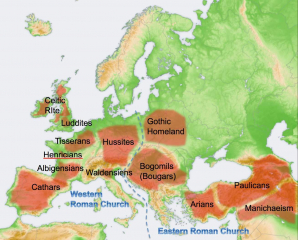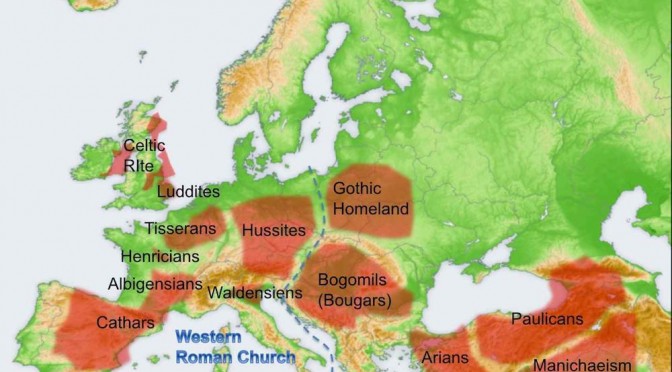Origins
The evidence which is available suggests that the cathar faith had very early beginnings, probably before the birth of Jesus. It is probably an amalgam of the earlier religions of Egypt, Persia, Sumer and India. The message was unified, simplified and made available to all by Jesus teaching. It was intended to eradicate the Jewish Messanic Faith and it’s inherent nationalism.
Heresy
The fathers of Church of Rome, determined to protect their Jewish heritage, adopted some of this alternative religion and tried to obscure the differences. They moved to eliminate any belief which departed in any way from their approved Liturgy.”Heresy” quickly changed in meaning from “different opinion” to “crime against faith”.
Commonality
In order to avoid recognition of the true strength of the alternative faith, the Church of Rome gave the the alternative faith a different name in all the territories in which it occured, stressing different aspects of the teaching in each place. In fact many of these different ‘Heresies’ were similar, perhaps identical.
 Very little is known about the Cathar faith which can be subjected to the normal academic proof of veracity.
What we do know is that it had very early beginnings, before the birth of Jesus. It is an amalgam of the earlier religions of Egypt, Persia, Sumer and India. The message was unified, simplified and made available to all by Jesus teaching.
The Church of Rome, determined to protect the Jewish heritage, adopted some of this alternative religion and tried to obscure the differences. The Emperor Constantine in allowing the Church of Rome to prosper failed to recognise these differences.
"Heracy" quickly changed in meaning from "different opinion" to "crime against faith".
In order to avoid recognition of the true strength of the alternative faith, the Church of Rome gave the faith a different name in all the territories in which it occured stressing different aspects of the teaching in each place.
Very little is known about the Cathar faith which can be subjected to the normal academic proof of veracity.
What we do know is that it had very early beginnings, before the birth of Jesus. It is an amalgam of the earlier religions of Egypt, Persia, Sumer and India. The message was unified, simplified and made available to all by Jesus teaching.
The Church of Rome, determined to protect the Jewish heritage, adopted some of this alternative religion and tried to obscure the differences. The Emperor Constantine in allowing the Church of Rome to prosper failed to recognise these differences.
"Heracy" quickly changed in meaning from "different opinion" to "crime against faith".
In order to avoid recognition of the true strength of the alternative faith, the Church of Rome gave the faith a different name in all the territories in which it occured stressing different aspects of the teaching in each place.
Cathar Beliefs
What then is this “Cathar” faith which the Church of Rome tried so hard to eradicate?
Cathar beliefs are so different that it is difficult to understand why they both call themselves Christians.
The Cathar faith is fundamentally different than the Christianity taught by the Church. Cathars believe that “God the father” of the Roman church is Set the Egyptian God of chaos,”The Demierge” or the Devil. The physical world is the Devil’s realm and this world is hell. Both the Old Testament and the New Testament of the Church of Rome are therefore inspired by the Devil and should be rejected. The Church of Rome betrays itself by its obsession with the material world; wealth, property, elaborate churches, extravagent lifestyles,bejewelled vestments and elaborate ceremonials.
The Church of Rome naturally sees all these beliefs as a dangerous attack on its establishment and a threat to its continuance as the leading European Religion. hence the Crusade, hence the Inquisition..
Essentially optimistic, Cathars believed that the Good God would eventually triumph.
Unlike the Church of Rome which enforced strict adherence to doctrine, the Cathar faith encourages discussions of the mysteries of faith and permits variations in belief.
[/column]
Both the Church of Rome and The Cathars believed that Jesus was a real person. That is about all they had in common.
When did the persecution start?
There was violence on the streets of Rome during the reigns of Tiberius, not long after the date given for Jesus death. the violence was repeated in the reigns of Gaius (Caligula) and Claudius. By the time of Claudius the violence had spread to Alexandria and other provincial capitals.
What were the "Jews" fighting about? By extrapolation backwards from subsequent events it seems obvious it was about religious differences.A history of persecution
Go to Summary ( text concatenation)
The Novgorod Codex
It was not just a Mediterranian phenomenon. Novgorod is a city situated between Moscow and St Petersburg. The Novgorod Codex found during the excavation of the city in 2000 contains many “hidden messages” including ” The world is a town in which people not forsaking the true faith in Christ are excluded from the church” Here carbon dating raises the possibility that the tablets were from the sixth century, but an academic historian has declared this date to be impossible because the texts are clearly related to christianity and christianity only reached the Kevian Rus in the tenth century.
Catharism
The Cathars are believed themselves to be unique. The argument is that the faith had thrived, in the roman empire away from the cities and in particular undisturbed in Occitan from the time of Jesus.The Cathar church had no possessions, no grand churches or bejewelled vestments, no ritual, ceremonies, sacraments or pagentry. Its liturgy was sparse and there was no formal hierachy organised on a geographical basis. This means that it was and is invisible to mainstream historians. Church of Rome used some of the Cathar’s modest piety to denegrate their faith.
